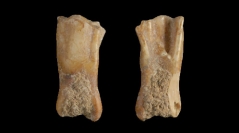

 Comptes Rendus Palevol
7 (6) - Pages 391-399
Comptes Rendus Palevol
7 (6) - Pages 391-399The discovery of new material in Late Pleistocene levels at Bolomor Cave (Valencia, Spain) raises some questions about the presence of the most ancient record of Hemitragus cedrensis in the peninsula, and its dispersal out of Provence. The morphology and dimensions of some lower teeth confirm the identification of H. aff. cedrensis. Moreover, it presents strong similarities, both morphological and metrical, with the specimens from Caune de l’Arago and bau de l’Aubesier (end of OIS 7 to OIS 5e) rather than with the population from the eponymous locality. The data suggest a dispersal event out of Provence towards the Iberian Peninsula during the Eemian. This dispersal was not stopped by natural barriers such as large rivers, or mountains. The results presented here confirm the biochronological interest of the genus Hemitragus for the Late Pleistocene in Mediterranean Europe.
Caprinae, Hemitragus, Bolomor Cave, Dispersal, Local evolution, Late Pleistocene, Spain